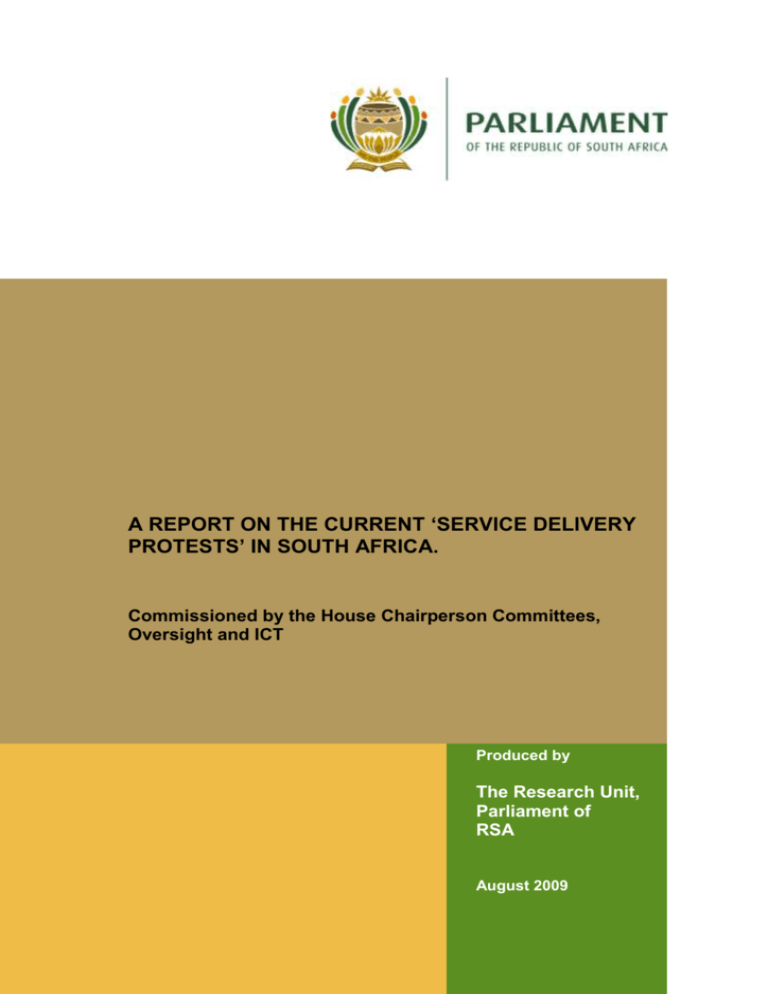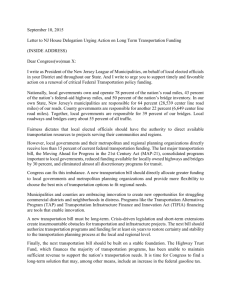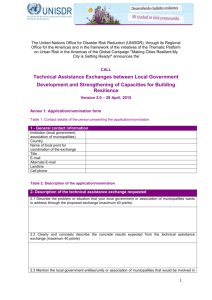091005report
advertisement

A REPORT ON THE CURRENT ‘SERVICE DELIVERY PROTESTS’ IN SOUTH AFRICA. Commissioned by the House Chairperson Committees, Oversight and ICT Produced by The Research Unit, Parliament of RSA August 2009 ‘Service delivery protests’ in SA TABLE OF CONTENTS SECTION PAGE 1. INTRODUCTION 1 2. PAST PROTESTS 1 2.1 Chronology of Past Protests 2 3. CURRENT PROTESTS 4 3.1 Chronology of Recent Protests 6 3.2 3.2.1 Issues and Concerns in Context Summary of Community Concerns 8 9 3.3 Analysis of Issues in Relation to Local Government 11 3.3.1 Recommendations 13 4. CONSTRAINTS AND CHALLENGES 14 4.1 4.1.1 4.1.2 4.1.3 Constraints Capacity Constraints within Municipalities Specific Areas of Capacity Constraints within Municipalities Recommendations 14 14 15 19 4.2 4.2.1 4.2.2 4.2.3 4.2.4 4.2.5 Challenges Conflicts of Interest Lack of Accountability Political Factionalism Violation of MFMA and Supply Chain Management Recommendations 21 21 21 22 22 24 5. 5.1 WHY ARE THE PROTESTS VIOLENT? Recommendations 26 26 6. CONCLUSION 27 REFERENCES APPENDIX 28 Executive Summary EXECUTIVE SUMMARY 1. INTRODUCTION Local Government has been under the spotlight in recent weeks due to a wave of protests which brought about clashes between protesting residents and law enforcement authorities. A myriad of concerns have been recorded, many of which have been categorised as ‘service delivery protests’ against local authorities which have been accused of poor service delivery. Many of the protests have been marked by exceptionally high levels of violence and vandalism. 2. CURRENT PROTESTS During the period January – June 2009, a total of 26 protests have been recorded – one short of last year’s total. The main provinces affected are: 3. Mpumalanga – e.g. Piet Retief and Balfour townships Gauteng – e.g. Thokoza and Diepsloot North West – e.g. Zeerust and Rustenberg Western Cape – e.g. Du Noon and Phillippi Free State – e.g. Jagersfontein and Kgotsong KwaZulu Natal – e.g. Durban and KwaMachibisa Eastern Cape – e.g. Duncan Village and Komga CAUSES The reasons put forward for the protests have included the following: 4. Lack of / Poor service delivery (water, sanitation, electricity, refuse removal) Lack of / Inadequate housing Evictions High levels of unemployment Lack of communication with communities Lack of leadership in the municipality Corruption Nepotism Maladministration Financial mismanagement CONSTRAINTS AND CHALLENGES Local and provincial authorities are struggling with a number of constraints and challenges which hamper their ability to deliver services. Among these are: Lack of capacity – Lack of the requisite skills has left many municipalities inadequately staffed, with grave implications for service delivery – for example, insufficient engineers has meant that the infrastructure for water and sanitation services has deteriorated ii Executive Summary badly over the years, leaving many communities with poor water quality, inadequate access to clean water and poor, to no, sanitation services. In addition, the lack of experienced staff with the requisite project management and financial skills, has meant that many municipalities are unable to properly manage and budget for their projects, leaving budgets unspent and projects urgently needed to uplift the lives of the poor, uncompleted. Poverty and unemployment - widespread and increasing levels of poverty and unemployment are fuelling the frustrations of impoverished communities, as well as increasing the number of people dependent on basic and indigent services. This makes further demands on the scarce resources of municipalities with large, impoverished communities and as a result, they struggle to deliver quality services. The Recession - the recession is also having a negative impact on the delivery of services - in particular, on the provision of services to the indigent. As the economic downturn deepens, more and more families are driven further into debt and poverty and are increasingly becoming more dependent on municipal services to the indigent. Under-spending by municipalities – this is due to poor project planning, poor management and/or lack of capacity, as many municipalities do not have staff with the requisite skills in these fields in order to ensure that funds allocated for service delivery and infrastructure maintenance, repair and development are in fact spent. Outstanding debt payments for municipal services from residents, businesses and government departments - the burden of debt carried by many municipalities is making it more and more difficult for them to meet their obligations in terms of service delivery. Conflicts of interest on the part of government officials who have business interests in entities which conduct business with national Government. Government officials who spend time focusing on their personal business interests at the expense of service delivery. Non-disclosure of financial interests by senior public servants harms the integrity of their departments and could cause conflicts of interest Senior officials often do not comply with regulations aimed at preventing conflicts of interest (e.g. submitting financial disclosure forms). Senior officials are often not held accountable when they do not comply with regulations aimed at preventing conflicts of interest. Senior officials are often not held accountable when they or their subordinates openly flout existing regulations prohibiting certain government employees (e.g. police) from doing business with the State. Senior officials are often not held accountable when they do not take the required action against subordinates who do not comply with regulations aimed at preventing conflicts of interest or prohibiting conducting business with the State. Political factionalism and infighting breeds nepotism, fraud and corruption which in turn, impacts heavily on the ability of municipalities to deliver services. Violation of MFMA and Supply Chain Management results in tender irregularities, which in turn fuels corruption, erodes confidence in municipal leadership and compromises service delivery. iii Executive Summary 5. WHY ARE THE PROTESTS VIOLENT? Research indicates that the possible reasons for violence can be attributed to: Aggression fuelled by intense prolonged the frustration. A sudden downturn in the economy triggering frustration and discontent, often leading to social unrest. The reinforcement of violence as being ‘acceptable’ in families and communities often leads to a vicious cycle of violence in those families and communities. Xenophobia, coupled with fierce competition for jobs and resources by poor South Africans, have often made foreigners targets of violence. Vindictiveness, anger, arguments and provocation can lead to physical violence. Group dynamics and power dynamics often play out in submission being enforced upon anyone perceived to be resistant, defiant or obstructive to a cause. Lack of confidence, due to the legacy of apartheid; perceived racism and/or discrimination; as well as a sense of ‘threatened masculinity’ in gender relations. Availability of, and easy access to, fire-arms and other kinds of weapons. Alcohol or substance abuse can lead to increased aggression. The existence of gang or criminal activities can result in the exploitation of protests by criminal elements. 6. RECOMMENDATIONS Poverty and Unemployment o o o o Enhance Capacity in Municipalities o o o Carry out urgent interventions aimed at the efficient and effective functioning and service delivery of municipalities. Ensure that budgets are spent by ensuring that properly qualified staff are employed. Improve socio-economic conditions in communities. Prioritise job creation and development for young people. Only employ properly qualified, experienced staff with the requisite specialist, technical and professional skills so that the current service delivery shortcomings (in relation to water, sanitation, electricity, housing and refuse removal) may be comprehensively addressed. Urgently implement skills upgrading training programmes among existing employees. Encourage the employment of retired specialists with needed skills. Address corruption, nepotism, maladministration o Ensure that all allegations of corruption, nepotism and maladministration are speedily dealt with, without fear or favour. iv Executive Summary o Prevent Conflicts of Interest o o o o o o Hold senior officials accountable when they or their subordinates do not comply with regulations aimed at preventing conflicts of interest (e.g. submitting financial disclosure forms). Punitive action should be taken against such managers and their subordinates. Hold senior officials accountable when they or their subordinates openly flout existing regulations prohibiting certain government employees (e.g. police) from doing business with the State. Punitive action should be taken against such managers and their subordinates. Hold senior officials accountable when they do not take the required action against subordinates who do not comply with regulations aimed at preventing conflicts of interest or prohibiting conducting business with the State. Consideration should be given to taking punitive action against such managers. Prevent / Address political factionalism o o Prevent government employees from joining companies or receiving payments from entities to which they had awarded tenders for a relatively long period after their resignation. Consideration should be given to imposing a blanket ban on government employees having business interests in entities which carry out work for the State. Consideration should be given to prohibiting all government employees from being involved in business (whether private or government) at all. Directors-General should be prohibited from being involved in business at all. Vigorously address the current lack of accountability o Ensure that transgressors are dealt with in a transparent manner and that those found guilty of corruption, nepotism or maladministration are held accountable. Political parties must take appropriate action to prevent factionalism from taking hold in municipalities and negatively affecting service delivery. Transgressors of official policies and regulations must be held to account for engaging in illegal activities and punitive action taken where necessary. Prevent / Address Violations of MFMA and Supply Chain Management o o o o o Strengthen accountability mechanisms. Build internal financial capacity. Act on recommendations emanating from audits. Correct maladministration. Take punitive action against transgressors v Executive Summary o Prevent violence o o o o o o o o 7. Undertake legal action to recover money lost through fraud and corruption. Implement effective policing. Carry out urgent interventions aimed at the efficient and effective functioning and service delivery of municipalities. Improve socio-economic conditions in communities. Prioritise job creation and development for young people. Politicians should refrain from making empty promises or creating unrealistic expectations. Establish youth violence prevention programmes in schools and combine these with leadership training, life skills development, and mentoring. Institutions such as universities can adopt and create partnerships with communities where they can provide counselling and psychological services at primary health care facilities to residents, workers from surrounding areas and school learners. Parliament should continue to press for accountability, as well as for clearly articulated and implemented legislation and policies in respect of migrant workers; immigrants and refugees in order to prevent a recurrence of xenophobic attacks. CONCLUSION The term, ‘service delivery protests’ is a misnomer since, while dissatisfaction with poor service delivery has certainly been a factor in triggering some of the protests, the causes of the protests are far more varied and complex than this. It must therefore be acknowledged that there are a multiplicity of factors at the root of the current protests and that these can best be placed into three broad categories: systemic (such as maladministration, fraud, nepotism and corruption in housing lists); structural (such as healthcare, unemployment, and land issues); and governance (such as weak leadership and the erosion of public confidence in leadership). Given the complex nature, as well as extent of the problem, it is clear that an integrated and holistic approach (which incorporates social, economic and political aspects) must form the foundation of any national strategy to resolve the situation. ___________________________________________________________________ vi







